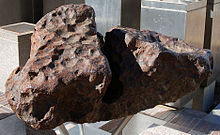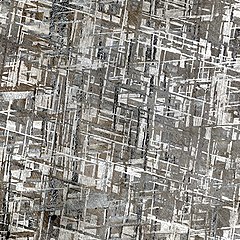Gibeon (meteorite)
| Gibeon | |
|---|---|

Gibeon meteorites in Post Street Mall, Windhoek
|
|
| Type | Iron |
| Structural classification | Fine octahedrite |
| Group | IVA |
| Composition | 91,8% Fe; 7,7% Ni; 0,5% Co; 0,04% P; 2,4 ppm Ir; 1,97 ppm Ga; 0,111 ppm Ge |
| Country | Namibia |
| Region | Great Namaqualand |
| Coordinates | 25°20′S 18°00′E / 25.333°S 18.000°ECoordinates: 25°20′S 18°00′E / 25.333°S 18.000°E |
| Observed fall | No |
| Fall date | prehistoric times |
| Found date | 1838 |
| TKW | 26000 kg |
| Strewn field | Yes |
 Widmanstätten pattern |
|
Gibeon is a meteorite that fell in prehistoric times in Namibia. It was named after the nearest town: Gibeon, Namibia.
The meteorite was discovered by the Nama people and used by them to make tools and weapons.
In 1836 the English captain J. E. Alexander collected samples of the meteorite in the vicinity of the Great Fish River and sent them to London. There John Herschel analyzed them and confirmed for the first time the extraterrestrial nature of the material.
The fragments of the meteorite in the strewn field are dispersed over an elliptical area 275 kilometres (171 mi) long and 100 kilometres (62 mi) wide.
The term Gibeon encompasses the whole meteoritic material fallen from the sky during this fall. This material is classified as iron meteorite belonging to the chemical group IVA.
Gibeon meteorites are composed of an iron-nickel alloy containing significant amounts of cobalt and phosphorus. The crystal structure of this meteorite provides a classic example of fine octahedrite and the Widmanstätten pattern is appreciated for its beauty both by collectors and designers of jewelry.
...
Wikipedia
